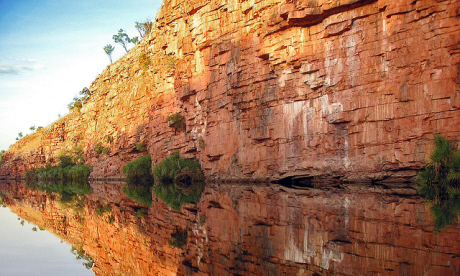
There's an up-and-coming part of Western Australia where you can get as lost as you want (and always be picked up again)
I’m glad I’ve never been too prone to sleepwalking, I mused as I looked down over the balcony edge. Directly below me the crocodile looked like an inflatable toy, its legs sticking straight out and its eyes glowing like red LEDs.
I was at El Questro Homestead and my room was perched directly above the Chamberlain Gorge. One day this huge expanse of Australian wilderness is going to be as well known as Kakadu or Uluru; right now it’s still private property and still being discovered.
In 1991 Will Burrell, an Eton-educated Englishman in his early 20s, spent a slice of the family fortune to pick up a million-acre, run-down, money-losing cattle station in the Kimberley, the far northern corner of Western Australia.
In subsequent years an awful lot more money followed the original million-dollar investment. Today, a steady stream of visitors head out along the Gibb River Road and turn off to the campsite (pitch your tent by the riverside for a charge per person), the rooms at Emma Gorge, the bungalows by the Pentecost River or, for big spenders, the Homestead, perched above the crocodiles on the Chamberlain Gorge – although that does include some fine food, high-quality booze and other worthwhile amenities.
For instance, you get Zebedee Springs all to yourself. In the late afternoon the ‘Do not disturb’ sign is hung out on the approach to these secluded hot springs and one of the El Questro rangers drops homestead guests off at the start of the walking track down to the springs with a winked hint that they may not need swimsuits. If that appeals then there’s an even more spectacular version available: the El Questro helicopter can drop you off at the beautiful plunge pool at the foot of Mirimiri Falls and come back for you an hour or two later. It’s not far by chopper, but allow a week if you want to walk there and back.
In between ferrying visitors to remote waterholes and Aboriginal rock-art sites, the helicopter is used to round up cattle. You can get an excellent taste of the magnificent gorges on foot – there are numerous walks available – but nothing can beat whirling through the ravines in a helicopter, the sheer rock walls soaring up on either side as you bank round the next sharp corner as if in some life-sized computer game.
It’s the gorges that make El Questro so memorable. They wind through the wilderness park, dotted with beautiful waterholes, punctuated by waterfalls, alive with birds and home to an extensive gallery of Aboriginal artwork. For Aboriginal art connoisseurs the El Questro region is a prime area for works of the Bradshaw and Wandjina schools. One of the art collections is just up the Chamberlain River beyond the Homestead; the boat trip there is one of the most popular El Questro excursions. Others can be reached by longer walks on foot, but for many of the more remote sites that trusty helicopter is the transport of choice for a ‘heli art tour’.
El Questro is open from March to November each year, then the wet season (aka the ‘green season’) rains come down and it simply submerges. The calm waterholes disappear under raging torrents, stretches of grassy plain become lakes, roads are cut and a skeleton staff remains at the Station Township.
Kununurra is the nearest reasonably-sized town and many visitors fly in there and drive the 100km to the station. If you’re planning to go further afield, or follow the notoriously corrugated Gibb River Road all 650km to the Indian Ocean coast, you’ll definitely need a 4WD.
And the name ‘El Questro’? To the early arrivals the red gorges looked like New Mexico, so they made up a Spanish sounding name for the region – it’s meaningless.
Maureen and Tony Wheeler founded Lonely Planet in 1973